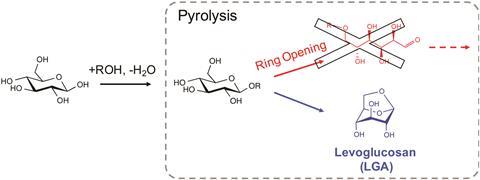Functionalising sugars could help to unlock the potential of biomass in chemical synthesis
A simple substitution can dramatically increase yields of a promising building-block molecule from biomass-based sugars, scientists in China and the US have found. Heat treatment (pyrolysis) of substituted glucose is over 90% selective for levoglucosan (LGA), allowing it to be investigated as a replacement to petrochemical feedstocks.

Typically, pyrolysis of carbohydrates such as cellulose produces complex mixtures of products, including LGA, which must then be laboriously separated. LGA has been identified by the US Department of Energy as a promising candidate biorefinery feedstock chemical with potential as a chiral precursor to antibiotics, antiparasitic agents, biologically active compounds and ‘green’ plastics.
However, cellulose pyrolysis produces a maximum of around 27% LGA, making it unsuitable as an industrial source of the chemical. Michael Wong and his group from Rice University and the Dalian Institute of Chemical Physics have developed a method for generating high-purity LGA by pyrolysing substituted glucose.
Pyrolysis of unsubstituted β-d-glucose is only 2–3% selective for LGA. But substituting the C1 hydroxyl with either an alkoxy or phenoxy group locks the sugar’s 6-membered pyranose ring. This blocks a lot of the competing reaction pathways, making the reaction up to 90% selective for LGA. The team applied the same kind of pre-treatment to complex carbohydrates like cellulose from paper and cotton, which also dramatically improved the selectivity for LGA production.












No comments yet